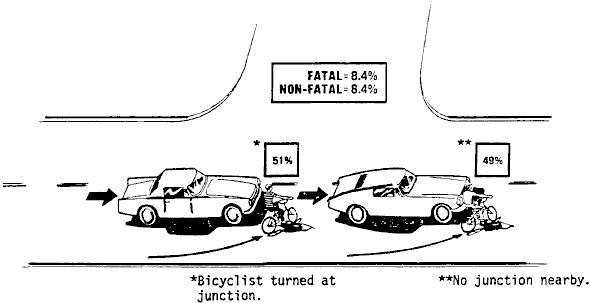
[Home Page]
[Up: Table of Contents]
[Previous: Section V, part 2]
[Next: Section VI]
[This long section has been divided into three parts
for Internet publication]
CLASS E PROBLEM TYPES: BICYCLIST UNEXPECTED TURN/SWERVEAll the accident cases classified into Problem Class E occurred when a bicyclist-suddenly and without warning--turned or swerved into the path of an overtaking motor vehicle or a motor vehicle approaching from directly ahead of the bicyclist. The cases within Class E were classified into four problem types that together accounted for 16.2% of the fatal cases and 14.2% of the non-fatal cases. Table 18 lists the descriptive titles for the Class E problem types and shows the proportion of fatal and non-fatal cases classified into each problem type. |
PROBLEM CLASS E--BICYCLIST UNEXPECTED TURN/SWERVE
| FATAL (N=166) |
NON- FATAL (N=753) |
||
|---|---|---|---|
| TYPE 18 | BICYCLIST UNEXPECTED LEFT TURN: PARALLEL PATHS, SAME DIRECTION | 8.4% | 8.4% |
| TYPE 19 | BICYCLIST UNEXPECTED LEFT TURN: PARALLEL PATHS, FACING APPROACH | 3.0% | 3.2% |
| TYPE 20 | BICYCLIST UNEXPECTED SWERVE LEFT: PARALLEL PATHS, SAME DIRECTION (UNOBSTRUCTED PATH) | 3.6% | 1.5% |
| TYPE 21 | WRONG-WAY BICYCLIST TURNS RIGHT: PARALLEL PATHS | 1.2% | 1.1% |
| TOTAL CLASS (N: FATAL = 27; NON-FATAL = 107) | 16.2% | 14.2% | |
PROBLEM-TYPE DESCRIPTIONSProblem Type 18 (8.4% Fatal; 8.4% Non-Fatal)Problem Type 18 is one of the most important problem types, both in terms of frequency of occurrence and injury severity. Every Type 18 accident occurred when a bicyclist suddenly turned left into the path of an overtaking motor vehicle. About one-half of the bicyclists turned left at the junction of a roadway or driveway, and the remaining bicyclists initiated their turn at a point that was not in close proximity to any type of junction. (This finding is illustrated by the two sets of vehicles shown in Figure 25.) Problem Type 18 does not include cases in which the bicyclist lost control of his bicycle and inadvertently swerved left. About one-half of the accidents occurred on a two-lane urban street and about 30% occurred on a two-lane rural roadway. The remaining 20% occurred with about equal frequency on urban and rural roadways with more than two lanes. Only seven percent of the fatal and two percent of the non-fatal accidents occurred during darkness, so degraded visibility is seldom a factor in accidents of this type. The apparent reason for the low incidence of nighttime accidents is that bicyclists can detect the headlights of overtaking motor vehicles without searching to the rear. |
Figure 25
Illustration of Problem Type 18,
Bicyclist Unexpected Left Turn: Parallel Paths, Same Direction.

| In 92% of the cases, it was judged that the motorist observed the bicyclist far enough
in advance to have easily avoided the accident. The motorist failed to initiate any type
of evasive action because he had no idea that the bicyclist intended to turn. A search
failure by the motorist was found in slightly less than five percent of the cases.
Conversely, a search failure by the bicyclist was evident in 94% of the cases. In the
remaining six percent of the cases, the bicyclist was aware of the overtaking motor
vehicle but incorrectly assumed there was sufficient time to cross the roadway before the
approaching motor vehicle arrived. It was known from pilot studies that accidents of this type occur frequently, so the Field Investigators were instructed to make a special attempt to determine why bicyclists fail to search behind before initiating a left turn. Although the interviews revealed a variety of different factors that may have contributed to the bicyclist's failure to search, it is believed that the most important contributing factors simply were not revealed by the interviews. Knowledge of the locations at which Type 18 accidents typically occur and informal discussions with many different bicyclists have led the author to the tentative conclusion that bicyclists often fail to search behind because they assume an overtaking motor vehicle can be heard if it is near enough to pose a threat. Some accidents may occur because the sound of the overtaking motor vehicle is masked by other auditory stimuli. Wind noise, conversations with riding companions, and the noise generated by motor vehicles approaching in the opposing lane are examples of common noises that may serve to mask the sound of an overtaking motor vehicle. The interview data indicated that other accidents may occur when a bicyclist hears an overtaking motor vehicle but misjudges its proximity or its approach velocity. However, whether the sound of the overtaking motor vehicle is masked or misinterpreted, the fundamental error is a total reliance on auditory cues. A probable secondary factor contributing to the bicyclist's failure to search concerns the degree of skill and effort required to search 180 degrees to the rear while maintaining lateral control of the bicycle. Searching to the rear without losing control of the bicycle is difficult under the best of circumstances, but is even more difficult when the bicyclist must simultaneously rotate the head and tilt it forward as is required when riding a bicycle with dropped handlebars. When riding a bicycle with dropped handlebars, many bicyclists look under their left arm when searching to the rear. This action requires the head to be tilted down about 90 degrees from vertical and rotated about 45 degrees to the left. Consequently, when searching to the rear, the vestibular mechanism is placed in a highly unusual position, and the signals from the vestibular system are equally unusual. Pilots of high-performance aircraft know that placing the head in an unusual position (tilting and/or rotating) while undergoing even moderate "g" forces creates unusual vestibular signals that, in turn, cause instant vertigo. It is hypothesized that bicyclists experience the same type of problems as aircraft pilots, only less severe. In summary, it is believed that bicyclists are reluctant to search behind because it is difficult to do so. The reluctance to search behind has led bicyclists to rely on auditory cues to detect overtaking motor vehicles whenever possible. When bicyclists are traveling a roadway with heavy and continuous traffic, they recognize the necessity to search behind before turning left. However, when traveling a roadway with light and/or sporadic traffic, they believe that auditory cues are adequate to detect overtaking motor vehicles and consider it safe to turn left when they fail to hear the sound of a nearby motor vehicle. Although auditory cues are reliable in most situations, there are some circumstances in which the sound of the overtaking motor vehicle is masked or distorted. It is in these situations that bicyclists turn left into the path of an overtaking motor vehicle. In about six percent of the Type 18 accidents, the bicyclist did search to the rear before turning but failed to observe the overtaking motor vehicle or misjudged its speed. In several cases, the motor vehicle that collided with the bicyclist was masked from view by another motor vehicle. The bicyclist searched behind and observed the lead vehicle, searched in a forward direction until it had passed, and turned into the path of the second (trailing) motor vehicle. At least three percent of the Type 18 accidents resulted from one bicyclist "blindly" following another. The lead bicyclist searched to the rear and correctly judged that he had enough time to turn left and clear the roadway before an overtaking motor vehicle arrived. Without searching to the rear, the trailing bicyclist followed the lead bicyclist--assuming that it was safe to turn. Although the trailing bicyclist turned shortly after the lead bicyclist initiated his turn, the lag time was great enough to place the trailing bicyclist on a collision course with the overtaking motor vehicle. Because bicyclists may be reluctant to admit that they were blindly following a lead bicyclist, it is probable that this behavior was a factor in more Type 18 accidents than was revealed by the interview data. Most of the bicyclists who were involved in Type 18 accidents were juveniles. The median age of the bicyclists was 12.7 years; five percent of the bicyclists were younger than seven years of age and 75% were 14 years of age or younger. Problem Type 19 (3.0% Fatal; 3.2% Non-Fatal)Like Problem Type 18, Problem Type 19 includes cases in which the bicyclist suddenly turned left into the path of the motorist. However, Problem Type 19 includes only the cases in which the bicyclist turned into the path of a motor vehicle approaching from straight ahead. Functionally, the most important differences between Problem Types 18 and 19 are the ease with which bicyclists can perform a search for the approaching motor vehicle (straight ahead vs. straight behind) and the amount of time the motorist has to respond once the bicyclist initiates his left-hand turn. Although it might be assumed that Type 19 accidents would occur most often on busy multiple-lane roadways, it was found that only 17% of the cases occurred on a roadway with more than two lanes. The remaining cases occurred on either a two-lane urban roadway (58%) or a two-lane rural roadway (25%). It was found that 96% of the accidents classified into Problem Type 19 occurred during the daytime. Figure 26 shows that only three-fourths of the bicyclists initiated their left-hand turn at a point that was in close proximity to a roadway or driveway junction. In the remaining cases, there was no junction of any kind near the point at which the bicyclist initiated his turn. The bicyclists in Figure 26 are shown turning from a point close to the right-hand edge of the roadway. Although such turns were most typical, the data show that about 29% of the bicyclists initiated their turn from a point close to the center of the roadway. Contrary to expectations, the bicyclists who were riding close to the center of the roadway prior to initiating their turn were >not on a multiple-lane roadway. |
Figure 26
Illustration of Problem Type 19,
Bicyclist Unexpected Left Turn: Parallel Paths, Facing Approach.
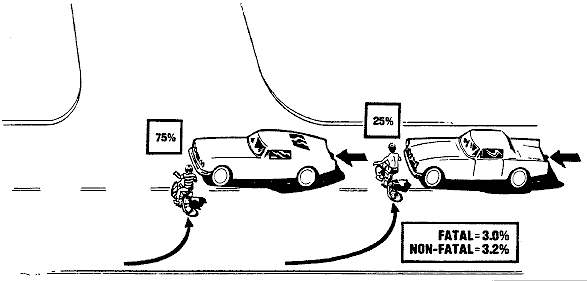
| (NOTE: Most, but not all, bicyclists initiated their left-hand turn at a point close to the right-hand edge of the roadway.) |
| Despite the fact that the motor vehicle was approaching from
directly ahead and was clearly visible to the bicyclist, it was found that at least 75% of
the bicyclists failed to search in the direction of the motor vehicle until an accident
was imminent. The proportion of search failures would probably have been higher, but the
bicyclist's function failure could not be confidently established in 12% of the cases.
Surprisingly, not a single case was found in which the bicyclist observed the motor
vehicle but misjudged its approach velocity. The bicyclist's search failure was most often
due to operator distractions. The types of distractions that most often contributed to the
bicyclist's search failure include: interacting with riding companion (41%),
vehicles/pedestrians considered an accident threat (24%), and game playing (12%). In
another 12% of the cases, it was found that the bicyclist's failure to search was due to
his faulty assumption that a riding companion would search for hazards and select a safe
course. About 70% of the motorists observed the bicyclist before he initiated his turn. Because of the narrowness of the roadway and the bicyclist's high-angle turn, it was judged that only about 10% of the motorists who were searching in the bicyclist's direction had sufficient time for evasive action once the bicyclist initiated his turn. These motorists failed to initiate evasive action because they assumed the bicyclist would slow or stop before entering the motor vehicle's path. Twelve percent of the motorists failed to search in the direction of the bicyclist. In eight percent of the cases, the motorist's view of the bicyclist was temporarily obstructed by a moving vehicle. Knowledge of the bicyclist's behavior in this situation would suggest that Type 19 accidents would most often involve very young bicyclists. Although young bicyclists were most frequently involved, half the bicyclists were older than 13 years of age and 25% were older than 18 years of age. The median age of the bicyclists was 13.8 years and five percent were younger than seven years of age. Problem Type 20 (3.6% Fatal; 1.5% Non-Fatal)Problem Type 20 includes accidents in which the bicyclist inadvertently swerved left and collided with an overtaking motor vehicle. Figure 27 shows the bicyclist swerving into the path of an overtaking motor vehicle, but some bicyclists swerved into the side of the motor vehicle. Accidents of this type occurred on urban two-lane streets (46%), urban streets with more than two lanes (27%), and on rural two-lane roadways (27%). Every case classified into Problem Type 20 occurred during the daytime. The most frequent reason for the bicyclist's inadvertent swerve was a prior collision with a curb (25%) or another bicycle (17%). Vehicle failures, operator skill deficiencies, and roadway-surface defects were each found to be a contributing factor in about 17% of the cases. In nearly every case, the motorist observed the bicyclist well in advance but had insufficient time to avoid the accident once the bicyclist swerved. |
Illustration of Problem Type 20,
Bicyclist Unexpected Swerve Left:
Parallel Paths, Same Direction (Unobstructed Path).
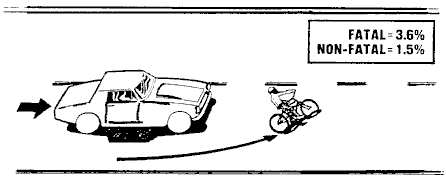
Accidents of this type seldom involved adult bicyclists. The median age of the
bicyclists for Problem Type 20 was 11.5 years. Only five percent of the bicyclists were
older than 17 years of age; 75% of the bicyclists were between 8.5 and 15.1 years of age.Problem Type 21 (1.2% Fatal; 1.1% Non-Fatal)Problem Type 21 includes accidents in which a bicyclist who had been riding facing traffic suddenly initiated a right-hand turn into the path of an approaching motor vehicle. Figure 28 shows the bicyclist turning into the path of a motor vehicle approaching from the opposite direction. Although most accidents occurred in this way, Problem Type 21 also includes accidents in which the bicyclist crossed the first half of the roadway and collided with an overtaking motor vehicle in the second half. However, only one case was found that occurred in this manner. Seventy-five percent of the accidents occurred on a two-lane urban street, and all Type 21 accidents occurred during the daytime. |
Illustration of Problem Type 21,
Wrong Way Bicyclist Turns Right: Parallel Paths.
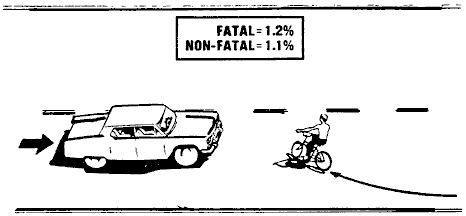
| In one case, it was found that the bicyclist's view of the oncoming motor vehicle was
obstructed by a parked vehicle. In the remaining cases, the bicyclist failed to search in
the motorist's direction because of a momentary distraction. In most cases, the bicyclist
was distracted by another person with whom he was riding (57%). Other distractors
contributing to the bicyclist's search failure include abnormal functioning of the bicycle
(14%), riding an unfamiliar bicycle (14%), and riding a bicycle that was too large for the
bicyclist (14%). Except for the one case in which the bicyclist emerged suddenly from behind a parked motor vehicle, the motorist observed the bicyclist soon enough to have avoided the accident if he had been able to anticipate the bicyclist's intention to turn. The bicyclists involved in Problem Type 21 varied in age from seven to 13 years. The sample was too small to obtain a reliable estimate of the centiles. EDUCATIONAL COUNTERMEASURES FOR CLASS E PROBLEM TYPESBicyclistsA study of Class E accidents suggests two types of education and training for bicyclists. First, education and training is needed to increase the bicyclist's propensity to search--both ahead and to the rear--and to signal prior to turning across the roadway. An important part of this training involves convincing bicyclists that auditory cues alone are not sufficient to signal the presence of an overtaking motor vehicle. Specifically, bicyclists should be taught that they should be alert to auditory cues but not to assume the absence of a motor vehicle because one cannot be heard. Because distractions often contributed to the bicyclist's search failure, bicyclists should be taught the importance of momentary distractors and how to overcome them. It is possible that the bicyclist's reluctance to scan to the rear can be overcome by training. Expert bicyclists claim that, through proper training, bicyclists can become quite proficient at scanning to the rear without veering. However, before such training is introduced on a large-scale basis, it would be necessary to conduct research to determine the type of training that is best and the extent to which proficiency at this task can be increased through training the target population for Class E accidents. Finally, when effective rear-vision devices become available, bicyclists should be taught how and when to use such devices. MotoristsIt is possible that some benefit would be derived from an education and training program designed to inform motorists of the frequency with which Class E accidents occur and to modify motorists' assumptions that a bicyclist will search and signal before initiating his turn. Certainly, motorists should be taught to give the bicyclist as wide a berth as possible when overtaking and passing. However, because of the suddenness of the bicyclist's turn, it is unlikely that such training would result in a substantial decrease in accidents of this type. CLASS F PROBLEM TYPES: MOTORIST UNEXPECTED TURNProblem Class F includes accidents that occurred when a motorist turned into the path of a bicyclist approaching from the motorist's front or rear. In nearly every case, the motorist failed to observe the bicyclist before initiating his turn--usually because the bicyclist was riding in an unexpected location. In some cases, the bicyclist failed to observe the turning motor vehicle until the accident was imminent. In most cases, however, the bicyclist observed the motor vehicle and either failed to anticipate the motorist's turn or incorrectly assumed that the motorist would delay his turn until the intersection was clear. As is shown in Table 19, Problem Class F accounted for 2.4% of the fatal cases and 14.5% of the non-fatal cases. The three problem types within Class F differ in terms of the motorist's direction of turn and the bicyclist's position and direction of travel relative to that of the motorist. |
TABLE 19
PROBLEM CLASS F--MOTORIST UNEXPECTED TURN
| FATAL (N=166) | NON- FATAL (N=753) |
|
|---|---|---|
| TYPE 22: MOTORIST UNEXPECTED LEFT TURN: PARALLEL PATHS, SAME DIRECTION | .6% | 1.3% |
| TYPE 23: MOTORIST UNEXPECTED LEFT TURN: PARALLEL PATHS, FACING APPROACH | --- | 7.6% |
| TYPE 24: MOTORIST UNEXPECTED RIGHT TURN: PARALLEL PATHS | 1.8% | 5.6% |
| TOTAL CLASS (N: FATAL = 4; NON-FATAL = 109) | 2.4% | 14.5% |
PROBLEM-TYPE DESCRIPTIONSProblem Type 22 (.6% Fatal; 1.3% Non-Fatal)Problem Type 22 includes accidents in which the motorist turned left into the path of a bicyclist approaching from the left-rear of the motor vehicle. Figure 29 shows that accidents of this type occurred in two distinctly different ways. In 60% of the cases, the bicyclist was traveling in the same direction and in the same lane as the motor vehicle. As the motor vehicle slowed in preparation for a left-hand turn, the bicyclist overtook and collided with the turning motor vehicle. In the remaining cases, the bicyclist was riding facing traffic along the left-hand edge of the roadway prior to the collision. |
Illustration of Problem Type 22,
Motorist Unexpected Left Turn: Parallel Paths, Same Direction.
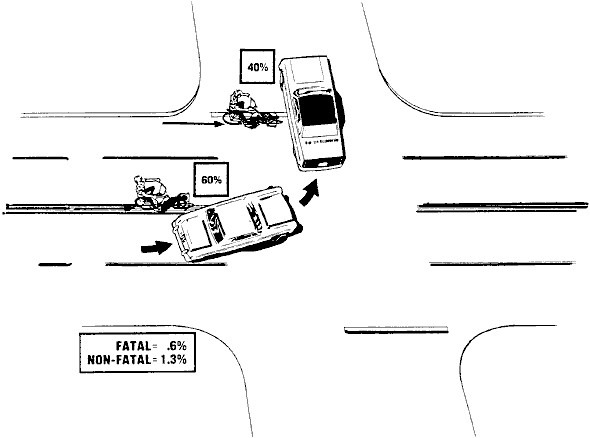
| Twenty percent of the accidents of this type occurred on a two-lane rural roadway. The
accidents that occurred in an urban area occurred with equal frequency on a two-lane
street and on a street with more than two lanes. Although 30% of the accidents occurred
during darkness, darkness was judged to be a contributing factor in only one case. In all
other cases, the bicyclists were riding in a location that was not searched by the
motorist. That is, it was judged that the accident would have occurred even if the
lighting conditions had been optimal. In 90% of the cases, the motorist failed to search in the bicyclist's direction before initiating his turn because he simply did not expect a threat to be approaching from that direction. Thirty percent of the bicyclists also failed to search and consequently failed to observe the motor vehicle until it was too late to avoid the accident. All the search failures were committed by the wrong-way-riding bicyclists. In the remaining cases, the bicyclist observed the motorist early enough to have avoided the accident. The bicyclist's failure to initiate evasive action upon observing the motor vehicle was due to his failure to anticipate the turn or his assumption that he had been detected by the motorist and that the motorist would yield to him. The median age of the bicyclists involved in Type 22 accidents was 15.9 years; fewer than five percent were younger than 12 years of age. Conversely, 25% of the bicyclists were older than 23.5 years of age. Problem Type 23 (7.6% Non-Fatal; No Fatal)Problem Type 23 includes cases in which the motorist turned left into the path of a bicyclist approaching from the opposite direction. Specific subtypes of Problem Type 23 are as follows:
Only three problem types accounted for more non-fatal cases than Problem Type 23; yet, not a single Type 23 accident was found among the fatal sample. Figure 30 shows that 86% of the bicyclists were riding legally in the roadway prior to the accident; the remaining bicyclists had been riding on the sidewalk before entering the junction where the collision occurred. Sixty percent of the accidents classified into Problem Type 23 occurred on an urban street with four or more lanes; 39% occurred on a two-lane urban street. Only four percent of the accidents occurred in a rural area. Accidents of this type occurred at a significant rate throughout the period between 6:00 AM and 11:00 PM; 13% of the accidents occurred during darkness. |
Figure 30
Illustration of Problem Type 23,
Motorist Unexpected Left Turn: Parallel Paths, Facing Approach.
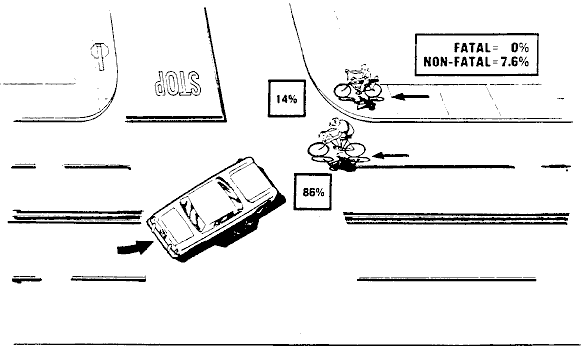
| The operator's view was obstructed by vegetation (bicyclist on sidewalk) or moving
motor vehicles in only six percent of the cases, so visual obstructions clearly are not an
important factor for this problem type. In nearly one-fifth of the
cases, the motorist failed to observe the bicyclist because of degraded visibility
conditions. In these cases, the motorist's visibility was degraded by one of the
following: darkness (14%), sun glare (6%), or glare from artificial lights (2%). Of the
bicyclists who went undetected by the motorist at night, one-half were equipped with an
operational headlamp. In 68% of the cases, the bicyclist was not observed by the motorist even though the motorist's view was unobstructed and the visibility conditions were good. Thirty-eight percent of the motorists reported that they scanned in the bicyclist's direction several times before turning but still failed to observe the bicyclist until the vehicles collided, or a moment before. It is probable that all the motorists who committed a search failure did, in fact, scan in the general direction of the bicyclist at least once. Thirty-six percent of the motorists reported that their search failure was at least partly due to distractions by vehicles or pedestrians that were considered an accident threat. An examination of the traffic context in which Type 23 accidents occurred would lead one to expect that information overload may have often contributed to the motorist's search failure. Although the information was seldom sufficient to clearly establish the presence of information overload, an evaluation of the traffic context indicates that this may have been a factor in at least half the cases in which a search failure was identified. Thirty percent of the bicyclists failed to search in the direction of the motor vehicle until it was too late to avoid the accident. The remaining bicyclists observed the motor vehicle but did not, or could not, initiate evasive action until the accident was imminent. Typical patterns of failures by the bicyclist are as follows:
It was found that the bicyclists involved in this type of accident were older than for any other problem type. The median age of the bicyclists was 20.1 years. Only 25% of the bicyclists were younger than 16 years of age and only five percent were younger than 11 years of age. Problem Type 24 (1.8% Fatal; 5.6% Non-Fatal) The distinguishing characteristic of Problem Type 24 is that a motorist collided with an approaching bicyclist while in the process of making a right-hand turn. Figure 31 shows that 74% of the accidents involved a bicyclist who was approaching from the motorist's right rear. This subtype typifies the classical right-turn accident that has been so widely publicized. In the remaining cases, the motorist turned into the path of a bicyclist approaching from straight ahead--riding facing traffic. |
Figure 31
Illustration of Problem Type 24,
Motorist Unexpected Right Turn: Parallel Paths.
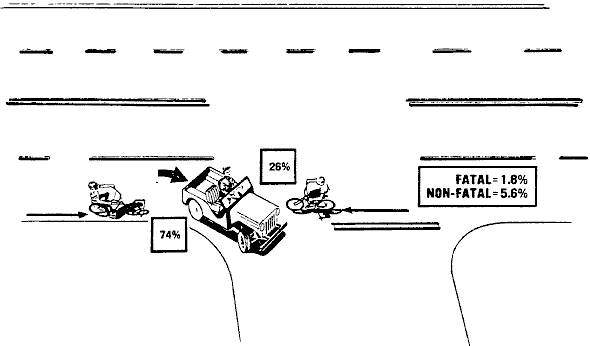
| Every accident of this type occurred in an urban area. In 59% of the cases, the
motorist was traveling on a two-lane urban street prior to the collision. In the remaining
cases, the motorist was traveling on a street with more than two lanes. Most accidents
occurred at either the junction of two roadways (64%) or the junction of a street and driveway (29%), but Problem Type 24 also includes a small number of
cases (7%) in which the motorist turned right to enter an on-street parking space. In most
cases, the bicyclist was traveling on the same roadway as the motorist. However, in eight
percent of the cases, the bicyclist entered the junction from a sidewalk. Ninety-five
percent of the accidents occurred during the daytime; 83% occurred during the period
between 11:00 AM and 6:00 PM. More than 97% of the motorists reported that they failed to observe the approaching bicyclist at the time they initiated their right-hand turn. In about five percent of the cases, the motorist's view of the bicyclist approaching from the rear was obstructed. In about 93% of the cases, however, the bicyclist was clearly visible to the motorist but went undetected because the motorist failed to scan carefully in the bicyclist's direction. The most common reasons given for the motorist's failure to search in the bicyclist's direction include:
About 12% of the bicyclists failed to search in the motorist's direction--usually because of momentary distractions. The remaining bicyclists observed the motorist far in advance but failed to correctly evaluate the motorist's intentions. In 24% of the cases, the motor vehicle was stopped in a queue of motor vehicles when first observed by the bicyclist. As the bicyclist approached the junction at which the accident occurred, the queue of motor vehicles began moving, which enabled the motorist to move to the junction where he intended to turn right. The bicyclist either failed to anticipate the motorist's turn or assumed he could clear the junction before the motorist turned. Only one case of this type involved a wrong-way-riding bicyclist. In about 64% of the cases, the bicyclist did not expect the motorist to turn, even though he observed the motor vehicle slow at the approach to the junction. In some cases the motorist failed to signal before turning; in other cases the motorist signaled but the bicyclist did not, or could not, see the signal. Because of conflicting testimony by the operators, it was impossible to estimate the number of cases in which the motorist failed to signal, the bicyclist failed to observe a clearly visible signal, or the bicyclist was riding alongside the motor vehicle and could not see the motor-vehicle's turn-signal light. However, it is estimated that these three situations occurred with about equal frequency. It was found that the bicyclists involved in accidents of this type varied widely in age. The median age was 16.8 years; about five percent of the bicyclists were 12 years of age or younger and 25% were older than 22 years of age. EDUCATIONAL COUNTERMEASURES FOR CLASS F PROBLEM TYPESBicyclistsAbout one-third of all Class F accidents were the direct or indirect result of bicyclists riding in an unexpected location (excluding bicyclists approaching from the rightrear of the motorist). Thus, bicyclist education and training programs should be designed to curtail the following behavior:
Whether or not bicyclists are riding in an expected location, they should be taught to search for motor vehicles that are in a position to turn (right or left) into their path. Although bicyclists should be taught to search for turn-signal lights and hand signals, they should also be taught that the lack of a signal does not necessarily mean that the motorist does not intend to turn. Bicyclists must be informed of the low conspicuity of the bicycle/bicyclist unit and taught to never assume that they have been observed by the motorist--even when the visibility conditions are good and the motorist scans in the bicyclist's direction. Finally, bicyclists must be informed of the dangers of overtaking and passing slow-moving or standing motor vehicles at junctions. Greatest emphasis should be placed on training to curtail passing on the right-hand side of slow-moving or standing motor vehicles. Some bicycling experts believe that many Class F accidents would not occur if bicyclists were taught to ride in the center of the traffic lane rather'than along the righthand curb. They claim that riding in the center of the traffic lane would increase the likelihood that the bicyclist will be detected by the motorist and would eliminate the right-of-way conflicts with right-turning accidents. As was discussed earlier, a number of critical questions must be answered before recommending that bicyclists be taught to ride in the center of the traffic lane (see discussion of countermeasures for Class E accidents). MotoristsThe main objective of a motorist education and training program is to modify motorists' search patterns in the traffic contexts where Class F accidents occur. An effective training and education program must increase motorists' expectations of encountering bicyclists and must teach them precisely where to search when preparing to make a lefthand or right-hand turn. CLASS G PROBLEM TYPES: OTHERClass G includes the problem types that could not meaningfully be classified into any of the previously described classes (see Table 20). With the exception of Problem Types 25 and 26, the problem types within Class G occurred so infrequently that it was not possible to draw valid inferences about the nature of the accident-generation process. For this reason, Problem Types 27 through 36 are described in only enough detail to provide a general notion of how the accident occurred. |
TABLE 20
PROBLEM CLASS G--OTHER
| FATAL (N=166) |
NON- FATAL (N=753) |
||
|---|---|---|---|
| TYPE 25 | VEHICLES COLLIDE AT UNCONTROLLED INTERSECTION: ORTHOGONAL PATHS | .6% | 2.8% |
| TYPE 26 | VEHICLES COLLIDE HEAD-ON, WRONG-WAY BICYCLIST | 2.4% | 3.6% |
| TYPE 27 | BICYCLIST OVERTAKING | .6% | .9% |
| TYPE 28 | HEAD-ON, WRONG-WAY MOTORIST | 1.8% | .8% |
| TYPE 29 | PARKING LOT, OTHER OPEN AREA: ORTHOGONAL PATHS | .6% | .8% |
| TYPE 30 | HEAD-ON, COUNTERACTIVE EVASIVE ACTION | --- | .1% |
| TYPE 31 | BICYCLIST CUTS CORNER WHEN TURNING LEFT: ORTHOGONAL PATHS | .6% | --- |
| TYPE 32 | BICYCLIST SWINGS WIDE WHEN TURNING RIGHT: ORTHOGONAL PATHS | --- | .3% |
| TYPE 33 | MOTORIST CUTS CORNER WHEN TURNING LEFT: ORTHOGONAL PATHS | --- | .4% |
| TYPE 34 | MOTORIST SWINGS WIDE WHEN TURNING RIGHT: ORTHOGONAL PATHS | --- | .1% |
| TYPE 35 | MOTORIST DRIVEOUT FROM ON-STREET PARKING | --- | .3% |
| TYPE 36 | WEIRD | --- | 1.1% |
| --- | INSUFFICIENT INFORMATION TO CLASSIFY | 7.2% | --- |
TOTAL CLASS (N: FATAL - 23; NON-FATAL = 84) |
13.8% | 11.2% | |
PROBLEM-TYPE DESCRIPTIONSProblem Type 25 (.6% Fatal; 2.8% Non-Fatal)Problem Type 25 includes cases in which (a) the collision occurred within an uncontrolled intersection and (b) the two vehicles approached on orthogonal legs of the intersection. Every case classified into Problem Type 25 occurred at the junction of a pair of two-lane roadways; 86% occurred in an urban area and 14% occurred in a rural area. Figure 32 shows that a slight majority of the accidents of this type occurred in the second half of the roadway (57%). Although not illustrated in Figure 32, about 25% of the bicyclists were riding on the wrong side of the roadway prior to the collision. Ninety percent of the accidents occurred during the daytime when visibility conditions were near optimal. Visual obstructions located close to the junction served to limit the motorist's preview time in 38% of the cases. Vegetation and parked motor vehicles were the most common type of obstructing objects. Darkness and inadequate bicycle lighting prevented the motorist from detecting the bicyclist in about ten percent of the cases. The remaining cases involved either a search failure or an evaluation failure by the motorist. In about 24% of the cases, the motorist failed to search in the direction of the bicyclist-usually because the bicyclist was traveling in an unexpected location (wrong-way riding). |
Illustration of Problem Type 25,
Vehicles Collide at Uncontrolled Intersection: Orthogonal Paths.
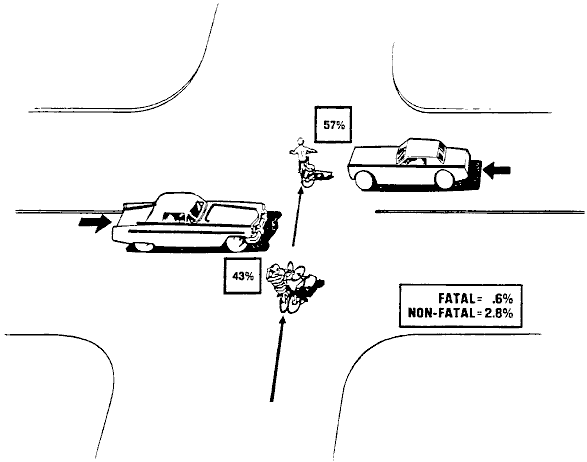
| The motorist observed the bicyclist early enough to have avoided the accident in 19$
of the cases. The motorist's failure to initiate evasive action was usually due to his
faulty assumption that the bicyclist would slow or turn before entering the junction. More than half the bicyclists failed to search effectively on their approach to the junction. Usually, the bicyclist's failure to search was due, in part, to distractions from game playing and interacting with a passenger or another bicyclist. About 19$ of the bicyclists observed the motor vehicle early enough to have avoided the accident but incorrectly assumed the motorist would turn or slow before reaching the bicyclist's intended path. About ten percent of the cases were due to an action failure -- usually due to faulty brakes or a skill deficiency in operating caliper brakes. A substantial number of the bicyclists who were involved in accidents of this type were very young. The median age of the bicyclists was 12.4 years. Five percent were six years of age or younger and only 25% were 14 years of age or older. Problem Type 26 (2.4% Fatal; 3.6% Non-Fatal)The accident cases classified into Problem Type 26 are highly similar to those classified into Class D (Motorist Overtaking/Overtaking Threat). The main difference is that all Type 26 accidents involved a wrong-way-riding bicyclist and, therefore, a head-on collision. Ninety-six percent of all Type 26 accidents occurred on a relatively narrow two-lane roadway; 55% of the accidents occurred in an urban area and 41$ occurred in a rural area. Seventy-eight percent of the accidents occurred during the daytime. Problem Type 26 contains five distinctly different subtypes; these subtypes are described briefly below. It should be noted that several of the subtypes of Problem Type 26 correspond closely to problem types within Class D.
Most of the bicyclists involved In Type 26 accidents were juveniles. The median age of the bicyclists was 12.9 years; about 70% of the bicyclists were between six and 15 years of age. Problem Type 27 (.6% Fatal; .9% Non-Fatal)Problem Type 27 includes cases in which the bicyclist collided with the rear of a stopped or slow-moving motor vehicle. About 43% of the accidents were the result of a search failure by the bicyclist, and an equal number were due to the bicyclist's failure to anticipate a sudden reduction in the motor vehicle's speed. In 14% of the cases, the bicyclist was unable to stop because of a skill deficiency in manipulating the caliper brakes. Problem Type 28 (1.8% Fatal; .8% Non-Fatal)All Type 28 collisions were head-on and involved a motor vehicle that was traveling on the wrong side of the roadway. Two cases involved a motor vehicle that was out of control. The other cases occurred as follows: • A truck offloading cement inched forward as a bicyclist approaching from straight ahead was preparing to swerve around the front of the truck. The motorist was leaving an unpaved area adjacent to the roadway and drove a short distance on the wrong side of the roadway. The motorist veered into the left lane when preparing to make a sharp right-hand turn. Problem Type 29 (.6% Fatal; .8% Non-Fatal)All Type 29 accidents occurred in a parking lot or another large open area (83% occurred in a commercial parking lot); the vehicles were traveling orthogonal paths in every case. Visual obstructions were a factor in about one-third of the cases. Otherwise, the accidents resulted from a search failure by one or both operators. Problem Type 30 (.1% Non-Fatal; No Fatal)Problem Type 30 includes accidents in which the vehicles collided head-on because both operators evaded in the same direction. Type 30 includes only the accidents that occurred on a roadway so narrow that neither vehicle can be said to have been traveling on the wrong side of the roadway. Problem Type 31 (.6% Fatal; No Non-Fatal)Problem Type 31 accidents (one case) occurred when a bicyclist cut a corner when turning left and collided with a motor vehicle approaching on an orthogonal leg of the intersection. Problem Type 32 (.3% Non-Fatal; No Fatal)Problem Type 32 includes cases in which the bicyclist swung too far to the left when making a high-speed right-hand turn. The bicyclist collided with a parked motor vehicle, a standing motor vehicle, or a moving motor vehicle located on the roadway onto which the bicyclist turned. Problem Type 33 (.4% Non-Fatal; No Fatal)Problem Type 33 is similar to Problem Type 31 except that Type 33 accidents resulted from the motorist (rather than the bicyclist) cutting a corner when making a left-hand turn. Problem Type 34 (.1% Non-Fatal; No Fatal)Problem Type 34 includes accidents in which the motorist swung wide when making a right-hand turn and collided with a bicyclist approaching an intersection in the roadway onto which the motorist turned. Problem Type 34 is the counterpart of Problem Type 32. Problem Type 35 (.3% Non-Fatal; No Fatal)Problem Type 35 includes accidents that occurred when a motorist drove into the path of an approaching bicyclist when exiting an on-street parking space (one case parallel-parking space and one case diagonal-parking space). Problem Type 36 (1.1% Non-Fatal; No Fatal)Problem Type 36 includes a variety of accidents termed "weird" because of the unusual circumstances that led to their occurrence. Examples include:
EDUCATIONAL COUNTERMEASURES FOR CLASS G PROBLEM TYPESThe educational countermeasures required to counter Type 25 accidents (vehicles collided at uncontrolled intersection) are similar to those suggested for the bicyclist driveout and motorist turn-merge/drive through accidents. Among the most important educational countermeasures for Problem Type 25 are:
The educational countermeasures for the remaining Class G accidents are similar to the countermeasures suggested for other problem types. Because of the great differences among Class G problem types, no attempt will be made to list the educational countermeasures for each of them. DESCRIPTION OF QUICK-REFERENCE TABLEThe persons who reviewed the material presented in this section of the report expressed a need for a single table that presents selected information about the composite set of problem types. Table 21 was prepared in response to that need. The first two columns of Table 21 show the designator for each problem type; the next column shows the generic description of each problem type. Columns four and five show the proportion of the fatal and non-fatal samples accounted for by each problem type. The remaining five columns show the 5th, 25th, 50th, 75th, and 95th centile age of the bicyclists who were involved in the associated problem type. A dashed line in these columns indicate that the sample was too small to provide a reliable estimate of the bicyclist age distribution for that problem type. Because of the small number of cases in the fatal sample, the centiles are based solely on the age of the bicyclists in the non-fatal sample. |
QUICK-REFERENCE TABLE
SHOWING RELATIVE FREQUENCY OF OCCURRENCE
AND BICYCLIST AGE DISTRIBUTION FOR EACH PROBLEM TYPE
| CLASS/TYPE DESIGNATOR |
PROBLEM-TYPE DESCRIPTION |
RELATIVE FREQUENCY OF OCCURRENCE | BICYCLIST AGE (CENTILES) | ||||||
|---|---|---|---|---|---|---|---|---|---|
| CLASS | TYPE | FATAL | NON- FATAL |
5TH | 25TH | 50TH | 75TH | 95TH | |
| A | 1 | BICYCLE RIDEOUT: RESIDENTIAL DRIVEWAY/ALLEY, PRE-CRASH PATH PERPENDICULAR TO ROADWAY | 6.7% | 5.7% | 5.2 | 7.4 | 9.8 | 12.3 | 15.9 |
| A | 2 | BICYCLE RIDEOUT: COMMERCIAL DRIVEWAY/ALLEY, PRE-CRASH PATH PERPENDICULAR TO ROADWAY | 2.4% | 3.2% | 7.6 | 9.4 | 13.8 | 14.9 | 24.9 |
| A | 3 | BICYCLE RIDEOUT: DRIVEWAY/ALLEY APRON, PRE-CRASH PATH PARALLEL TO ROADWAY | 2.4% | 2.5% | 5.9 | 9.6 | 11.5 | 13.1 | 16.0 |
| A | 4 | BICYCLE RIDEOUT: ENTRY OVER SHOULDER/CURB | 3.6% | 2.5% | 6.9 | 9.5 | 11.5 | 14.5 | 15.0 |
| B | 5 | BICYCLE RIDEOUT: INTERSECTION CONTROLLED BY SIGN | 7.8% | 10.2% | 6.8 | 9.1 | 11.8 | 14.3 | 19.4 |
| B | 6 | BICYCLE RIDEOUT: INTERSECTION CONTROLLED BY SIGNAL, SIGNAL PHASE CHANGE | .6% | 3.1% | 10.1 | 13.3 | 16.1 | 17.8 | 32.8 |
| B | 7 | BICYCLE RIDEOUT: INTERSECTION CONTROLLED BY SIGNAL, MULTIPLE THREAT | 2.4% | 2.0% | 11.8 | 12.9 | 15.2 | 15.9 | 33.2 |
| B | - | BICYCLE RIDEOUT: INTERSECTION CONTROLLED BY SIGNAL, OTHER | 1.2% | 1.7% | 9.6 | 13.9 | 16.9 | 23.9 | 34.4 |
| C | 8 | MOTORIST TURN-MERGE: COMMERCIAL DRIVEWAY/ ALLEY | --- | 5.3% | 7.9 | 13.3 | 15.4 | 17.5 | 49.9 |
| C | 9 | MOTORIST TURN-MERGE/ DRIVE-THROUGH: INTERSECTION CONTROLLED BY SIGN |
1.2% | 10.2% | 10.4 | 13.8 | 16.3 | 20.5 | 35.6 |
| C | 10 | MOTORIST TURN-MERGE: INTERSECTION CONTROLLED BY SIGNAL | --- | 1.9% | 10.6 | 12.1 | 13.3 | 24.4 | 72.4 |
| C | 11 | MOTORIST BACKING FROM RESIDENTIAL DRIVEWAY | --- | .8% | - | - | - | - | - |
| C | 12 | MOTORIST DRIVEOUT: CONTROLLED INTERSECTION | 1.2% | .5% | - | - | - | - | - |
| D | 13 | MOTORIST OVERTAKING: BICYCLIST NOT OBSERVED | 24.6% | 4.0% | 11.2 | 15.4 | 18.1 | 23.2 | 59.6 |
| D | 14 | MOTORIST OVERTAKING: MOTOR VEHICLE OUT OF CONTROL | 4.2% | .7% | - | - | - | - | - |
| D | 15 | MOTORIST OVERTAKING: COUNTERACTIVE EVASIVE ACTION | 2.4% | 1.7% | 5.7 | 9.2 | 12.3 | 14.4 | 15.7 |
| D | 16 | MOTORIST OVERTAKING: MOTORIST MISJUDGED SPACE REQUIRED TO PASS | 1.8% | 2.0% | 8.7 | 13.5 | 15.0 | 25.2 | 41.3 |
| D | 17 | MOTORIST OVERTAKING: BICYCLIST'S PATH OBSTRUCTED | .6% | 2.0% | 9.1 | 12.9 | 16.3 | 23.2 | 32.2 |
| D | - | MOTORIST OVERTAKING: TYPE UNKNOWN | 4.2% | .1% | - | - | - | - | - |
| E | 18 | BICYCLIST UNEXPECTED LEFT TURN: PARALLEL PATHS, SAME DIRECTION | 8.4% | 8.4% | 7.2 | 10.6 | 12.7 | 14.5 | 20.9 |
| E | 19 | BICYCLIST UNEXPECTED LEFT TURN: PARALLEL PATHS, FACING APPROACH | 3.0% | 3.2% | 6.2 | 11.7 | 13.8 | 18.5 | 35.8 |
| E | 20 | BICYCLIST UNEXPECTED SWERVE LEFT: PARALLEL PATHS, SAME DIRECTION (UNOBSTRUCTED PATH) | 3.6% | 1.5% | 8.5 | 10.2 | 11.5 | 15.1 | 16.4 |
| E | 21 | WRONG-WAY BICYCLIST TURNS RIGHT: PARALLEL PATHS | 1.2% | 1.1% | - | - | - | - | - |
| F | 22 | MOTORIST UNEXPECTED LEFT TURN: PARALLEL PATHS, SAME DIRECTION | .6% | 1.3% | 11.5 | 13.5 | 15.9 | 23.5 | 37.5 |
| F | 23 | MOTORIST UNEXPECTED LEFT TURN: PARALLEL PATHS, FACING APPROACH | --- | 7.6% | 10.8 | 15.7 | 20.1 | 26.6 | 46.2 |
| F | 24 | MOTORIST UNEXPECTED RIGHT TURN: PARALLEL PATHS | 1.8% | 5.6% | 12.1 | 14.6 | 16.8 | 22.9 | 33.9 |
| G | 25 | VEHICLES COLLIDE AT UNCONTROLLED INTERSECTION: ORTHOGONAL PATHS | .6% | 2.8% | 6.0 | 9.3 | 12.4 | 13.9 | 19.9 |
| G | 26 | VEHICLES COLLIDE HEAD-ON, WRONG-WAY BICYCLIST | 2.4% | 3.6% | 6.5 | 10.9 | 12.9 | 15.3 | 20.5 |
| G | 27 | BICYCLIST OVERTAKING | .6% | .9% | - | - | - | - | - |
| G | 28 | HEAD-ON, WRONG-WAY MOTORIST | 1.8% | .8% | - | - | - | - | - |
| G | 29 | PARKING LOT, OTHER OPEN AREA: ORTHOGONAL PATHS | .6% | .8% | - | - | - | - | - |
| G | 30 | HEAD-ON, COUNTERACTIVE EVASIVE ACTION | --- | .1% | - | - | - | - | - |
| G | 31 | BICYCLIST CUTS CORNER WHEN TURNING LEFT: ORTHOGONAL PATHS | .6% | --- | - | - | - | - | - |
| G | 32 | BICYCLIST SWINGS WIDE WHEN TURNING RIGHT: ORTHOGONAL PATHS | --- | .3% | - | - | - | - | - |
| G | 33 | MOTORIST CUTS CORNER WHEN TURNING LEFT: ORTHOGONAL PATHS | --- | .4% | - | - | - | - | - |
| G | 34 | MOTORIST SWINGS WIDE WHEN TURNING RIGHT: ORTHOGONAL PATHS | --- | .1% | - | - | - | - | - |
| G | 35 | MOTORIST DRIVEOUT FROM ON-STREET PARKING | --- | .3% | - | - | - | - | - |
| G | 36 | WEIRD | --- | 1.1% | - | - | - | - | - |
| G | 37 | INSUFFICIENT INFORMATION TO CLASSIFY | 7.2% | --- | - | - | - | - | - |
| [Home Page] [Up: Table of Contents] [Previous: Section V, part 2] [Next: Section VI] |
Contents copyright © 1978, |